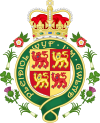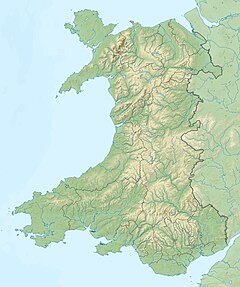Capital of Wales

| This article is part of a series within the Politics of the United Kingdom on the |
| Politics of Wales |
|---|
 |
The current capital of Wales is
History
Between the end of
In the past, multiple places have served as a seat of the government of Wales, including:
- Abergwyngregyn the seat of the Kingdom of Gwynedd
- Llywelyn the Great held council in 1238.[3]
- Machynlleth, where Owain Glyndŵr held a parliament in 1404.[4]
- Ludlow (Welsh Llwydlo, in Shropshire, England), seat of the Council of Wales and the Marches from 1473 to 1689.[5]
The ecclesiastical capital of Wales is St Davids, the resting place of the country's patron saint, Saint David.
In the 19th century, Cardiff grew to become the largest settlement in Wales, due to its role as a port for exporting coal from the
In the 20th century, Welsh local authorities debated where a new capital of Wales should be, with 76 out of 161 opting for Cardiff in a 1924 poll, organised by the
Recognition of Cardiff
The government of the Labour Prime Minister, Clement Attlee, had not named a capital of Wales during his government. Attlee noted that a number of cities made claims to the status, and that the Council for Wales and Monmouthshire did not raise what he considered to be a "domestic issue" with the Government.[12] In his inaugural speech as Lord Mayor of Cardiff, George Williams argued that Cardiff should be considered the capital of Wales.[13] David Llewellyn was elected MP for Cardiff North in 1950 and also campaigned for recognising Cardiff. Campaigning for Cardiff stepped up and the city took steps to promote its 'Welshness'. The stalemate over which city should be the new capital was broken when Cardiganshire County Council decided to support Cardiff and, in a 1955 poll of local authorities, 134 out of 161 voted for the city.[11]
On 20 December 1955,
Government institutions
Cardiff only became a centre of national administration with the establishment of the Welsh Office in 1964, which later prompted the creation of various other public bodies such as the Arts Council of Wales and the Welsh Development Agency, most of which were based in Cardiff.
In a 1997 referendum, Wales narrowly voted in favour of establishing the National Assembly for Wales (now known as the Senedd), although only 44% supported the proposal in Cardiff.[15][16] Due to the relative lack of support for the Assembly locally, and disagreements between the Welsh Office and Cardiff Council over where it should sit, there was a brief period of speculation that the Assembly would be established elsewhere.[17][18] However, the Assembly eventually located at Tŷ Hywel in Cardiff Bay in 1999. It has been based there ever since, moving to its present building in 2006.[19]
References
- ISBN 978-0-85115-533-3.
- ^ The Welsh King and his Court, T. M. Charles-Edwards, Morfydd E. Owen, Paul Russell (2000), p.326-7
- Welsh History Review, 29 (3).
- ^ "Owain Glyndwr Centre in Machynlleth reopens". BBC News. 18 June 2013. Retrieved 21 December 2013.
- ^ Carradice, Phil (7 November 2012). "The Council of Wales and the Marches". Retrieved 21 December 2013.
- ISBN 978-0-521-43816-2.
- ISBN 978-0-7546-5067-6. Retrieved 2 October 2008.
- ^ "About NLW". National Library of Wales. Retrieved 21 December 2013.
- ISBN 978-0-7083-1953-6.
- ISBN 9781108603201– via Google Books.
- ^ S2CID 144368404.
- ^ "Capital City (Hansard, 13 June 1950)". Parliamentary Debates (Hansard). 13 June 1950. Retrieved 20 December 2018.
- ^ "Capital City: 13 Jun 1950: House of Commons debates". TheyWorkForYou. Retrieved 20 December 2018.
- ^ Hansard 20 December 1955 vol 547 cc310-1W
- OCLC 44411917.
- ^ "Wales: The Post-Nation" (PDF). Archived from the original (PDF) on 8 April 2008. Retrieved 20 May 2008.
- ^ "Where To Now for the Welsh Assembly?". BBC Wales. 25 November 1997. Retrieved 20 May 2008.
- ^ "Welsh Assembly Accommodation" (PDF). 2 October 1997. Archived from the original (PDF) on 28 May 2008. Retrieved 20 May 2008.
- ^ Owen, Twm (19 December 2021). "Architect Richard Rogers who designed the Senedd has died". The National. Retrieved 19 December 2021.

